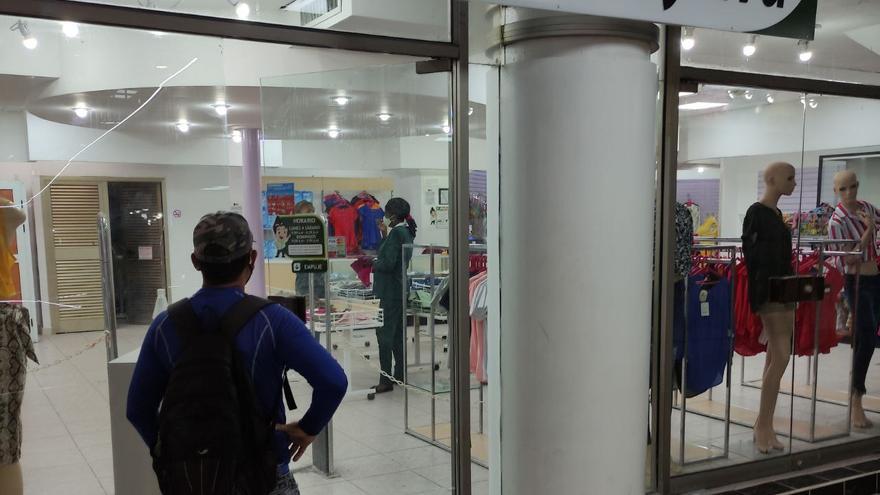
![]() 14ymedio/EFE, Havana, 8 February 2022 — This Tuesday, Alejandro Gil, Cuba’s Minister of Economy and Planning, defended the opening of stores that operate exclusively in hard foreign currency, arguing that, without them “the country’s economic situation would be even more complex”.
14ymedio/EFE, Havana, 8 February 2022 — This Tuesday, Alejandro Gil, Cuba’s Minister of Economy and Planning, defended the opening of stores that operate exclusively in hard foreign currency, arguing that, without them “the country’s economic situation would be even more complex”.
Gil told the Cuban News Agency (ACN) that “although many do not see it that way, it is a measure of social justice, because it allows us to redistribute currency based on the supply of the commercial peso-based networks,” although he recognized that “these are adjustment measures that carry a cost,” since they know “that the population cannot fully meet their needs in these establishments in MLC*.”
The stores in MLC began to operate in Cuba at the end of 2019, first with offers of electrical appliances, hardware or furniture to capture the “dollars that were escaping the country,” in the words of the Minister, from people who traveled to nearby countries to buy merchandise and then resell it in the informal market.
The initial objective of the MLC was to use foreign currency “according to the development of the national industry, and to maintain a stable level of offers in pesos”
In July 2020, the sale of food and toiletries was allowed in them, a very controversial measure, because they are the best-stocked stores, but most Cubans deal in pesos and do not have access to dollars. With the implementation of the economic reform package in 2021, known as the Tarea Ordenamiento [Ordering Task]**, they expanded their sales to clothing, shoes and other items, including strollers and cribs.
Added to this is the growing gap between the official exchange rate, at 24 pesos per dollar, and the informal market exchange rate, which stands at almost 100 pesos.
The initial objective of the MLC’s was to use foreign currency “according to the development of the national industry, and to maintain a stable level of offers in pesos,” said Gil, who argued that “nobody calculated that an epidemic would make the situation even more complex.”
For the average Cuban, the beginning of these measures taking effect coincided with the shortage of food and medicine, and the results meant standing in long lines for hours to acquire basic products, almost always concentrated in the stores in MLC.
In this regard, the head of the Ministry of Economy explained that “there is a group of products that we have to offer in this currency, but if tomorrow we switch them to be traded in the national currency, they will last 15 days and then there won’t be any, neither in hard currency nor in pesos.”
He also pointed out that from the sales in MLC “more than 300 million dollars were used to supply merchandise to the trade network in national currency,” but the truth is that these remain unsupplied.
Regarding the growing inflation in Cuba, the Minister insisted that the way to deal with it “is associated precisely with the increase in offers by the State in national currency, which is not achieved overnight.”
Despite everything, Gil insisted on the “temporary nature” of the decision “whose objective is being fulfilled,” and reiterated that the MLC stores will continue to operate depending “on the recovery of the economy and when we can bestow real buying power onto the Cuban peso.”
Regarding the growing inflation in Cuba, the Minister assured that the way to deal with it “is associated precisely with the increase in offers by the State in national currency, which is not achieved overnight”
The 2021 financial year closed with inflation above 70% in retail markets, according to the government, although some experts estimate real inflation (including the informal market) at around 500%.
As is usual with the Cuban authorities, Gil mentioned, among the reasons for the supply shortages, the US economic sanctions and the impact of Covid-19, and in no case, “a problem by design, as many consider.”
Months ago, the Government itself acknowledged before the National Assembly that the “design problems” of the Code and the “difficulties” of its implementation, partly due to the national and global economic situation, generated “deviations,, “errors” and “unwanted results,” in addition to “multiple dissatisfactions among the population”.
Gil himself announced last December that a “survey of all entities that sell in unauthorized MLC” would be carried out, but this Tuesday he did not provide information on how that process is going, a process the Minister considered fundamental to aid in fighting the rise in prices.
Translator’s notes:
*MLC = Moneda Libremente Convertible / literally: Money Freely Convertible
**Tarea ordenamiento = the [so-called] ‘Ordering Task’ which is a collection of measures that include eliminating the Cuban Convertible Peso (CUC), leaving the Cuban peso as the only national currency, raising prices, raising salaries (but not as much as prices), opening stores that take payment only in hard currency which must be in the form of specially issued pre-paid debit cards, and other measures.
Translated by Norma Whiting
Related article: ‘Dollar Stores are a Lifeline’
____________
COLLABORATE WITH OUR WORK: The 14ymedio team is committed to practicing serious journalism that reflects Cuba’s reality in all its depth. Thank you for joining us on this long journey. We invite you to continue supporting us by becoming a member of 14ymedio now. Together we can continue transforming journalism in Cuba.
